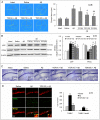Protection of TGF-β1 against neuroinflammation and neurodegeneration in Aβ1-42-induced Alzheimer's disease model rats
- PMID: 25658940
- PMCID: PMC4319949
- DOI: 10.1371/journal.pone.0116549
Protection of TGF-β1 against neuroinflammation and neurodegeneration in Aβ1-42-induced Alzheimer's disease model rats
Abstract
Neuroinflammation has been reported to be associated with Alzheimer's disease (AD) pathogenesis. Neuroinflammation is generally considered as an outcome of glial activation; however, we recently demonstrated that T helper (Th)17 cells, a subpopulation of proinflammatory CD4+ T cells, are also involved in AD pathogenesis. Transforming growth factor (TGF)-β1, a cytokine that can be expressed in the brain, can be immunosuppressive, but its effects on lymphocyte-mediated neuroinflammation in AD pathogenesis have not been well addressed. In the current study we administered TGF-β1 via intracerebroventricle (ICV) and intranasal (IN) routes in AD model rats to investigate its antiinflammatory and neuroprotective effects. The AD rat model was prepared by bilateral hippocampal injection of amyloid-β (Aβ)1-42. TGF-β1 was administered via ICV one hour prior to Aβ1-42 injection or via both nares seven days after Aβ1-42 injection. ICV administration of TGF-β1 before Aβ1-42 injection remarkably ameliorated Aβ1-42-induced neurodegeneration and prevented Aβ1-42-induced increases in glia-derived proinflammatory mediators (TNF-α, IL-1β and iNOS), as well as T cell-derived proinflammatory cytokines (IFN-γ, IL-2, IL-17 and IL-22), in the hypothalamus, serum or cerebrospinal fluid (CSF) in a concentration-dependent manner. TGF-β1 pretreatment also prevented Aβ1-42-induced decreases in the neurotrophic factors, IGF-1, GDNF and BDNF, and in the antiinflammatory cytokine, IL-10. Similarly, IN administration of TGF-β1 after Aβ1-42 injection reduced neurodegeneration, elevation of proinflammatory mediators and cytokines, and reduction of neurotrophic and antiinflammatory factors, in the hypothalamus, serum or CSF. These findings suggest that TGF-β1 suppresses glial and T cell-mediated neuroinflammation and thereby alleviates AD-related neurodegeneration. The effectiveness of IN administered TGF-β1 in reducing Aβ1-42 neurotoxicity suggests a possible therapeutic approach in patients with AD.
Conflict of interest statement
Figures






Similar articles
-
TGF-β1 protection against Aβ1-42-induced neuroinflammation and neurodegeneration in rats.Int J Mol Sci. 2014 Dec 1;15(12):22092-108. doi: 10.3390/ijms151222092. Int J Mol Sci. 2014. PMID: 25470026 Free PMC article.
-
TGF-β1 protection against Aβ1-42-induced hippocampal neuronal inflammation and apoptosis by TβR-I.Neuroreport. 2018 Jan 17;29(2):141-146. doi: 10.1097/WNR.0000000000000940. Neuroreport. 2018. PMID: 29200096
-
Th17 cell-mediated neuroinflammation is involved in neurodegeneration of aβ1-42-induced Alzheimer's disease model rats.PLoS One. 2013 Oct 4;8(10):e75786. doi: 10.1371/journal.pone.0075786. eCollection 2013. PLoS One. 2013. PMID: 24124514 Free PMC article.
-
Dysfunction of TGF-β1 signaling in Alzheimer's disease: perspectives for neuroprotection.Cell Tissue Res. 2012 Jan;347(1):291-301. doi: 10.1007/s00441-011-1230-6. Epub 2011 Aug 31. Cell Tissue Res. 2012. PMID: 21879289 Review.
-
Neurobiological links between depression and AD: The role of TGF-β1 signaling as a new pharmacological target.Pharmacol Res. 2018 Apr;130:374-384. doi: 10.1016/j.phrs.2018.02.007. Epub 2018 Feb 10. Pharmacol Res. 2018. PMID: 29438781 Review.
Cited by
-
The Biology of Glial Cells and Their Complex Roles in Alzheimer's Disease: New Opportunities in Therapy.Biomolecules. 2018 Sep 10;8(3):93. doi: 10.3390/biom8030093. Biomolecules. 2018. PMID: 30201881 Free PMC article. Review.
-
Carnosine Prevents Aβ-Induced Oxidative Stress and Inflammation in Microglial Cells: A Key Role of TGF-β1.Cells. 2019 Jan 17;8(1):64. doi: 10.3390/cells8010064. Cells. 2019. PMID: 30658430 Free PMC article.
-
Carnosine Decreases PMA-Induced Oxidative Stress and Inflammation in Murine Macrophages.Antioxidants (Basel). 2019 Aug 6;8(8):281. doi: 10.3390/antiox8080281. Antioxidants (Basel). 2019. PMID: 31390749 Free PMC article.
-
Plasma Rich in Growth Factors (PRGF) Disrupt the Blood-Brain Barrier Integrity and Elevate Amyloid Pathology in the Brains of 5XFAD Mice.Int J Mol Sci. 2019 Mar 25;20(6):1489. doi: 10.3390/ijms20061489. Int J Mol Sci. 2019. PMID: 30934587 Free PMC article.
-
TGF-β1 Provides Neuroprotection via Inhibition of Microglial Activation in 3-Acetylpyridine-Induced Cerebellar Ataxia Model Rats.Front Neurosci. 2020 Mar 20;14:187. doi: 10.3389/fnins.2020.00187. eCollection 2020. Front Neurosci. 2020. PMID: 32265625 Free PMC article.
References
-
- Schwab C, McGeer PL (2008) Inflammatory aspects of Alzheimer disease and other neurodegenerative disorders. J Alzheimers Dis 13: 359–369. - PubMed
Publication types
MeSH terms
Substances
LinkOut - more resources
Full Text Sources
Other Literature Sources
Medical
Research Materials
Miscellaneous

